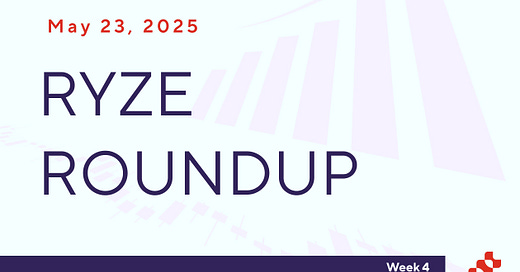Market Commentary
Bitcoin hit a new all-time high of $111,800 on Thursday, an ironic milestone on Bitcoin Pizza Day. The rally came despite rising macro pressures and reinforces BTC’s growing role as a non-correlated asset amid fiscal and policy uncertainty.
This week’s most notable macro event was Moody’s downgrade of the U.S. sovereign credit rating on May 16, citing mounting concerns over the $36 trillion federal debt load. Yet, risk markets barely blinked. Bitcoin and major altcoins all posted gains, suggesting that markets have largely priced in fiscal deterioration, or are choosing to look past it for now.
Bond markets, however, reacted sharply. The 10-year Treasury yield rose to 4.59%, and the 30-year spiked to 5.09%. This move reflects growing discomfort over the U.S.’s fiscal trajectory, inflation risks linked to tariffs, and weak auction demand. Treasury volatility continues to signal underlying stress even as equities and crypto rally.
The absence of progress in U.S.-China trade talks remains a wildcard, but it was not a market mover this week.
What’s noteworthy is the strength of Bitcoin in the face of surging long-end yields, an environment that historically pressured risk assets. The market’s resilience suggests a shifting macro narrative, where BTC may be increasingly viewed as a hedge against both sovereign risk and policy dysfunction.
We continue to monitor Treasury market behavior and geopolitical developments closely. But for now, the bid for Bitcoin remains strong, and the market is sending a clear signal.
Key News and Events
Anza Proposes Alpenglow: A Major Upgrade to Solana’s Consensus Layer
Anza, a core development team spun out from Solana Labs, has introduced Alpenglow, a new consensus protocol designed to significantly improve finality latency and network efficiency on Solana. This marks the most substantial overhaul to Solana’s core protocol since inception, replacing TowerBFT and Proof-of-History with a new architecture centered on two components: Votor for consensus logic and Rotor for data propagation.
Alpenglow aims to achieve block finality in as little as 100–150 milliseconds by eliminating redundant message passing and leveraging a more direct communication model. Votor introduces a dual-path voting mechanism—finalizing blocks in a single round when 80% of stake is responsive, or in two rounds when only 60% is available. These voting processes run concurrently, allowing the protocol to finalize as soon as either threshold is met.
Rotor, the new data dissemination protocol, refines Solana’s existing Turbine approach. It distributes block data using erasure coding and stake-weighted single-layer relay nodes, ensuring efficient bandwidth utilization and minimizing propagation latency. Rotor also introduces an adaptive routing strategy, dynamically optimizing data paths and improving network fault tolerance.
Simulation results suggest that under the current mainnet stake distribution, Alpenglow can consistently achieve sub-second finality with minimal computational overhead. The system is also designed with enhanced fault tolerance, capable of sustaining operations even when 20% of stake is adversarial and another 20% is offline, under specific network assumptions.
The proposal is currently undergoing review via the Solana Improvement Document (SIMD) process. Testnet deployment is expected by mid-2025, with a potential mainnet rollout following successful validation. If adopted, Alpenglow could position Solana to support real-time, high-throughput applications such as decentralized trading, instant settlement, and event-driven dApps that demand Web2-level responsiveness
USD1 Stablecoin: An Emerging Force Connecting Traditional Finance and Blockchain
Launched in March 2025 by World Liberty Financial (WLFI), USD1 has quickly gained traction, reaching a market cap of $2.2 billion—now the seventh-largest stablecoin globally. Backed by U.S. Treasury bonds, dollar deposits, and cash equivalents, USD1 is primarily issued on BNB Chain and utilizes Chainlink’s CCIP for multi-chain operability.
Its rise has been supported by key institutional backing, including a $2 billion investment in Binance by Abu Dhabi’s MGX Investment Fund via USD1. Huobi was the first exchange to launch USD1 trading in early May, followed by listings on Binance and KuCoin this week, significantly expanding its reach.
WLFI’s influence in the ecosystem is growing. On May 21, Binance Alpha listed B-token (@BUILDonBsc_AI), which surged 651% after WLFI publicly supported the asset. USD1 is also now accepted as collateral on Falcon Finance, a synthetic yield platform with over $125 million in TVL, underscoring its early utility in DeFi.
USD1 is closely tied to the GENIUS Act, a proposed U.S. Senate bill advancing regulatory clarity for stablecoins. The bill, which passed a key vote on May 20, mandates full backing by short-term Treasuries and U.S. dollars and aims to support the global role of the digital dollar. If passed by June, the act could cement USD1’s regulatory standing and further position it as a key player in the stablecoin market.
With institutional backing, exchange integrations, and potential regulatory tailwinds, USD1 is emerging as a credible alternative to established stablecoins, aiming to connect traditional capital markets with blockchain-based infrastructure.






